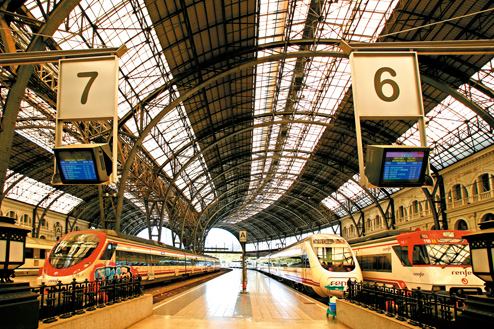Tourism
Tourism accounts for a great deal of Barcelona’s rapidly rising economy. In 1990, 1.7 million tourists visited the city, by 2000 this figure was above 3.1 million and by 2005 it had passed five million. Catalonia’s capital is especially popular for short stays, and was winner of the 2006 British Travel award for top short break destination. New ferry terminals have also become popular for cruise liners. This has brought an enormous number of tourists, stopping to do some guerrilla-style sightseeing and shopping. An extraordinary total of nine UNESCO World Heritage sites, adds to the popular appeal. The Gaudí trail alone has seven, including La Sagrada Familia , the incredible unfinished church designed by Gaudí.
Barcelona’s museums are incredibly popular, with the recently revamped Museu Picasso and the innovative CosmoCaixa science museum (www.cosmocaixa.com) among the most visited. Tourisme de Barcelona reckons that the city’s ‘places of interest’ receive more than 17 million visitors a year.
The city’s vibrant, chaotic nightlife attracts Europe’s young and trendy (along with drunken stags and hens). And the buzzing and highly-regarded Catalonian gastronomic scene lures in the gourmet crowd.
Beyond the purely hedonistic, Barcelona is also the world’s third top congress destination, with several historic locations for receptions and gala events. The newly unveiled CCIB international convention centre, south-east Europe’s biggest, is capable of hosting up to 15,000 people. Business trips, conventions and fairs account for 53.5 % of visitors. Imaginative plans to increase tourism however, are still constantly being hatched. The Barcelona Science 2007 program (www.bcn.cat/ciencia2007) saw exhibitions and workshops in 80 different research centers, institutes, colleges and other sites. To allow for the ever-swelling tourist ranks, the number of hotels are rising rapidly, from 187 in 2000 to 268 in 2005 and counting. By 2008 there should be some 30,000 hotel rooms available.
Barcelona’s museums are incredibly popular, with the recently revamped Museu Picasso and the innovative CosmoCaixa science museum (www.cosmocaixa.com) among the most visited. Tourisme de Barcelona reckons that the city’s ‘places of interest’ receive more than 17 million visitors a year.
The city’s vibrant, chaotic nightlife attracts Europe’s young and trendy (along with drunken stags and hens). And the buzzing and highly-regarded Catalonian gastronomic scene lures in the gourmet crowd.
Beyond the purely hedonistic, Barcelona is also the world’s third top congress destination, with several historic locations for receptions and gala events. The newly unveiled CCIB international convention centre, south-east Europe’s biggest, is capable of hosting up to 15,000 people. Business trips, conventions and fairs account for 53.5 % of visitors. Imaginative plans to increase tourism however, are still constantly being hatched. The Barcelona Science 2007 program (www.bcn.cat/ciencia2007) saw exhibitions and workshops in 80 different research centers, institutes, colleges and other sites. To allow for the ever-swelling tourist ranks, the number of hotels are rising rapidly, from 187 in 2000 to 268 in 2005 and counting. By 2008 there should be some 30,000 hotel rooms available.













